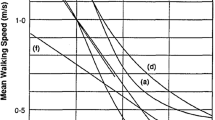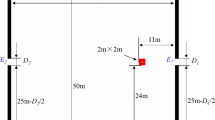Abstract
Building fires are one of the most common fire types and tend to cause heavy casualties. During the evacuation, the shortest path makes the escapees leave the accident scene faster. Meanwhile, the safety of escapees in the evacuation process cannot be ignored. Optimal path should both ensure evacuation efficiency and maximize the safety of escapees. A bi-objective path planning model, which considers both path risk and path length, is presented. Path risk is based on five risk factors that are likely to cause casualties in a fire: carbon monoxide (CO), hydrogen cyanide (HCN), temperature, visibility, and crowding. The linear weighted sum method is used to convert the risk-objective model and the length-objective model into a dynamic bi-objective path planning model. The Dijkstra algorithm is modified to solve the model. The modified algorithm outperforms the traditional Dijkstra algorithm in terms of both efficiency and adjustment ability. The simulation analysis of a building fire shows that the bi-objective model and algorithm can plan a combined optimal evacuation path for escapees considering risk and path length, which avoids the area with high risk level and optimizes the evacuation path length.







Similar content being viewed by others
References
Luo Y-x, Li Q, Jiang L-r, Zhou Y-h (2021) Analysis of Chinese fire statistics during the period 1997–2017. Fire Saf J 125:6–7
Lu S, Mei P, Wang J, Zhang H (2012) Fatality and influence factors in high-casualty fires: a correspondence analysis. Saf Sci 50(4):1019–1033. https://doi.org/10.1016/j.ssci.2011.12.006
Atec A, Hull R (2010) Fire Statistics. Woodhead Publishing Limited and CRC Press LLC, London
Pursals SC, Garzón FG (2009) Optimal building evacuation time considering evacuation routes. Eur J Oper Res 192(2):692–699. https://doi.org/10.1016/j.ejor.2007.10.004
Liu M, Zhang F, Ma Y, Pota HR, Shen W (2016) Evacuation path optimization based on quantum ant colony algorithm. Adv Eng Inform 30(3):259–267. https://doi.org/10.1016/j.aei.2016.04.005
Cuesta A, Abreu O, Balboa A, Alvear D (2017) Real-time evacuation route selection methodology for complex buildings. Fire Saf J 91:947–954. https://doi.org/10.1016/j.firesaf.2017.04.011
Li X, Li Q, Claramunt C (2018) A time-extended network model for staged evacuation planning. Saf Sci 108:225–236. https://doi.org/10.1016/j.ssci.2017.08.004
Aleksandrov M, Cheng C, Rajabifard A, Kalantari M (2019) Modelling and finding optimal evacuation strategy for tall buildings. Saf Sci 115:247–255. https://doi.org/10.1016/j.ssci.2019.02.017
Gao H, Medjdoub B, Luo H, Zhong H, Zhong B, Sheng D (2020) Building evacuation time optimization using constraint-based design approach. Sustain Cities Soc 9:7–8
Cao Y, Luo C, Liu Y, Teng S, Xin G (2021) Path intelligent optimization for dense crowd emergency evacuation in heritage buildings. J Cult Herit 47:180–187. https://doi.org/10.1016/j.culher.2020.06.007
Kurdi H, Almulifi A, Al-Megren S, Youcef-Toumi K (2021) A balanced evacuation algorithm for facilities with multiple exits. Eur J Oper Res 289(1):285–296. https://doi.org/10.1016/j.ejor.2020.07.012
Miñambres MD, Llanos DR, Gento AM (2022) Extending and validating a theoretical model to predict the effectiveness of building evacuations. J Build Eng. https://doi.org/10.1016/j.jobe.2022.104256
von Schantz A, Ehtamo H (2022) Minimizing the evacuation time of a crowd from a complex building using rescue guides. Phys A: Stat Mech Appl. https://doi.org/10.1016/j.physa.2022.127011
Balboa A, González-Villa J, Cuesta A, Abreu O, Alvear D (2020) Testing a real-time intelligent evacuation guiding system for complex buildings. Saf Sci. https://doi.org/10.1016/j.ssci.2020.104970
Wang J, Yu X, Zong R, Lu S (2022) Evacuation route optimization under real-time toxic gas dispersion through CFD simulation and Dijkstra algorithm. J Loss Prev Process Ind. https://doi.org/10.1016/j.jlp.2022.104733
Faouzi Kamouna MEB (2021) Fatna Belqasmic, Abderrazak Hachania A smart dynamic crowd evacuation system for exhibition centers. Procedia Comput Sci 184:218–225
Wang Y, Ma W, Wang T, Liu J, Wang X, Sean M et al (2022) Dynamic optimisation of evacuation route in the fire scenarios of offshore drilling platforms. Ocean Eng. https://doi.org/10.1016/j.oceaneng.2022.110564
Chu JC, Chen AY, Lin Y-F (2017) Variable guidance for pedestrian evacuation considering congestion, hazard, and compliance behavior. Transp Res Part C Emerg Technol 85:664–683. https://doi.org/10.1016/j.trc.2017.10.009
Mirahadi F, McCabe BY (2021) EvacuSafe: a real-time model for building evacuation based on Dijkstra’s algorithm. J Build Eng. https://doi.org/10.1016/j.jobe.2020.101687
Song Y, Niu L, Liu P, Li Y (2021) Fire hazard assessment with indoor spaces for evacuation route selection in building fire scenarios. Indoor Built Environ 31(2):452–465. https://doi.org/10.1177/1420326x21997547
Shi X, Gai W, Xu K (2022) Bi-objective rescue path selection optimization for mine fires based on quantitative risk assessment. Saf Sci. https://doi.org/10.1016/j.ssci.2021.105492
He Z, Liu C, Chu X, Negenborn RR, Wu Q (2022) Dynamic anti-collision A-star algorithm for multi-ship encounter situations. Appl Ocean Res. https://doi.org/10.1016/j.apor.2021.102995
Ikeda Y, Inoue M (2016) An Evacuation route planning for safety route guidance system after natural disaster using multi-objective genetic algorithm. Procedia Comput Sci 96:1323–1331. https://doi.org/10.1016/j.procs.2016.08.177
Samany NN, Sheybani M, Zlatanova S (2021) Detection of safe areas in flood as emergency evacuation stations using modified particle swarm optimization with local search. Appl Soft Comput. https://doi.org/10.1016/j.asoc.2021.107681
Liu H, Xu B, Lu D, Zhang G (2018) A path planning approach for crowd evacuation in buildings based on improved artificial bee colony algorithm. Appl Soft Comput 68:360–376. https://doi.org/10.1016/j.asoc.2018.04.015
Contreras-Cruz MA, Ayala-Ramirez V, Hernandez-Belmonte UH (2015) Mobile robot path planning using artificial bee colony and evolutionary programming. Appl Soft Comput 30:319–328. https://doi.org/10.1016/j.asoc.2015.01.067
Wang H, Mao W, Eriksson L (2019) A Three-dimensional dijkstra’s algorithm for multi-objective ship voyage optimization. Ocean Eng. https://doi.org/10.1016/j.oceaneng.2019.106131
Biyela P, Rawatlal R (2019) Development of an optimal state transition graph for trajectory optimisation of dynamic systems by application of Dijkstra’s algorithm. Comput Chem Eng 125:569–586. https://doi.org/10.1016/j.compchemeng.2019.03.025
Fink W, Baker VR, Brooks AJW, Flammia M, Dohm JM, Tarbell MA (2019) Globally optimal rover traverse planning in 3D using Dijkstra’s algorithm for multi-objective deployment scenarios. Planet Space Sci. https://doi.org/10.1016/j.pss.2019.104707
Shukla DK, Arul AJ (2021) An efficient Dijkstra’s semaphore based k-out-of-n Petri net voting model: An application to shutdown actuation system reliability. Ann Nucl Energy. https://doi.org/10.1016/j.anucene.2021.108218
Kim D, Kim D, Woo D, Lee Y (2022) Development of an image analysis code for hydrided Zircaloy using Dijkstra’s algorithm and sensitivity analysis of radial hydride continuous path. J Nucl Mater 564:3–5. https://doi.org/10.1016/j.jnucmat.2022.153647
Zhou Y, Huang N (2022) Airport AGV path optimization model based on ant colony algorithm to optimize Dijkstra algorithm in urban systems. Sustain Comput: Inform Syst. https://doi.org/10.1016/j.suscom.2022.100716
Yuan Y, Wang D (2009) Path selection model and algorithm for emergency logistics management. Comput Ind Eng 56(3):1081–1094. https://doi.org/10.1016/j.cie.2008.09.033
Zhang J, Zhao J, Song Z, Gao J (2020) Evacuation performance of participants in an offshore platform under smoke situations. Ocean Eng. https://doi.org/10.1016/j.oceaneng.2020.107739
Huo F, Li Y, Li C, Ma Y (2022) An extended model describing pedestrian evacuation considering pedestrian crowding and stampede behavior. Physica A. https://doi.org/10.1016/j.physa.2022.127907
NRC (2010) Acute Exposure Guideline Levels for Selected Airborne Chemicals:, vol 8. National Academies Press (US), Washington
NRC (2002) Acute Exposure Guideline Levels for Selected Airborne Chemicals:, vol 2. National Academies Press (US), Washington
Casey C. Grant PE, John R. HallJr. PD, Robert E. Solomon PE (2008) NFPA-Fire Protection Handbook-2008–20th. National Fire Protection Association, Quincy, Massachusetts
Ibrahim AM, Venkat I, Subramanian KG, Khader AT, Wilde PD (2016) Intelligent evacuation management systems. ACM Trans Intell Syst Technol 7(3):1–27. https://doi.org/10.1145/2842630
Xu K, Gai W-m, Salhi S (2021) Dynamic emergency route planning for major chemical accidents: Models and application. Saf Sci. https://doi.org/10.1016/j.ssci.2020.105113
García-Ojeda JC, Bertok B, Friedler F, Fan LT (2013) Building-evacuation-route planning via time-expanded process-network synthesis. Fire Saf J 61:338–347. https://doi.org/10.1016/j.firesaf.2013.09.023
Balboa A, González-Villa J, Cuesta A, Abreu O, Alvear D (2020) Testing a real-time intelligent evacuation guiding system for complex buildings. Saf Sci 132:104970–104972
National Fire and Rescue Administration (China). Nearly ten years 35 group deaths and injuries in fires killed 677 people, these reasons caused such a major casualty. 2020. Available from: https ://www.119.gov.cn/gk/sjtj/2022/1337.shtml.
Acknowledgements
The authors appreciate the financial supports from College Students’ Innovative Entrepreneurial Training Plan Program (202210060018).
Author information
Authors and Affiliations
Corresponding author
Ethics declarations
Conflict of interest
We declare that we do not have any commercial or associative interest that represents a conflict of interest in connection with the work submitted.
Additional information
Publisher's Note
Springer Nature remains neutral with regard to jurisdictional claims in published maps and institutional affiliations.
Rights and permissions
Springer Nature or its licensor (e.g. a society or other partner) holds exclusive rights to this article under a publishing agreement with the author(s) or other rightsholder(s); author self-archiving of the accepted manuscript version of this article is solely governed by the terms of such publishing agreement and applicable law.
About this article
Cite this article
Guan, W., Hou, S., Yu, G. et al. Dynamic Evacuation Path Planning for Multi-Exit Building Fire: Bi-Objective Model and Algorithm. Fire Technol 59, 2853–2876 (2023). https://doi.org/10.1007/s10694-023-01448-x
Received:
Accepted:
Published:
Issue Date:
DOI: https://doi.org/10.1007/s10694-023-01448-x




